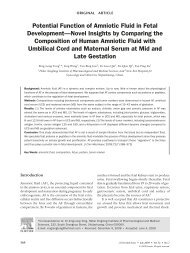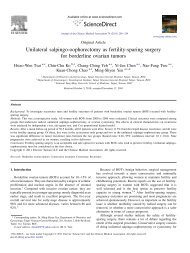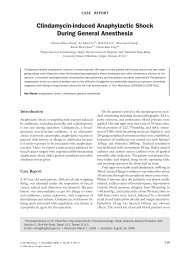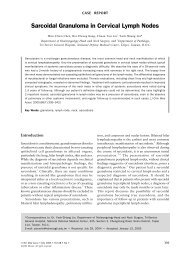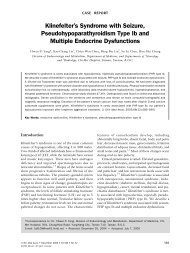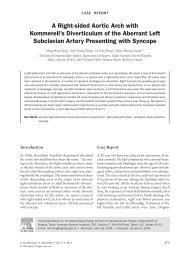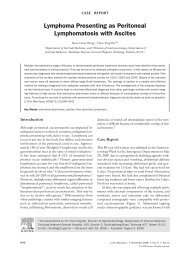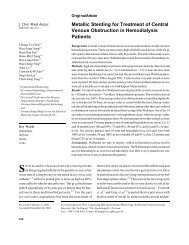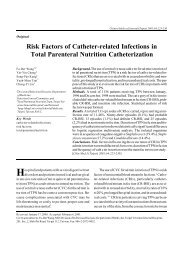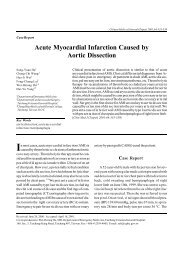Anaplastic Thyroid Cancer with Uncommon Long-term Survival
Anaplastic Thyroid Cancer with Uncommon Long-term Survival
Anaplastic Thyroid Cancer with Uncommon Long-term Survival
Create successful ePaper yourself
Turn your PDF publications into a flip-book with our unique Google optimized e-Paper software.
CASE<br />
REPORT<br />
<strong>Anaplastic</strong> <strong>Thyroid</strong> <strong>Cancer</strong> <strong>with</strong> <strong>Uncommon</strong><br />
<strong>Long</strong>-<strong>term</strong> <strong>Survival</strong><br />
Ai-Hung Liu 1 , Li-Ying Juan 1 , An-Hang Yang 2,3 , Harn-Shen Chen 1,3 , Hong-Da Lin 1,3 *<br />
1 Division of Endocrinology and Metabolism, Department of Medicine and 2 Department of Pathology,<br />
Taipei Veterans General Hospital, and 3 National Yang-Ming University School of Medicine,<br />
Taipei, Taiwan, R.O.C.<br />
In general, most thyroid cancers are indolent and have a slowly progressive course. The exception is anaplastic thyroid<br />
cancer. It is one of the most fatal neoplasms in humans, <strong>with</strong> median survival of 4–12 months. Here, we present a<br />
patient <strong>with</strong> anaplastic thyroid cancer who survived for more than 10 years after diagnosis. A 68-year-old man was incidentally<br />
found to have anaplastic thyroid cancer during operation for follicular neoplasm. Total thyroidectomy was performed<br />
and hyperfractionated radiotherapy was carried out. After operation, annual follow-up examinations were negative<br />
for residual tumor or metastatic lesions. The patient also had chronic obstructive pulmonary disease and unfortunately<br />
died of pneumonia in a local hospital 10 years after thyroid operation. [J Chin Med Assoc 2006;69(10):489–491]<br />
Key Words: anaplastic thyroid cancer, hyperfractionated radiotherapy, thyroidectomy<br />
Introduction<br />
<strong>Anaplastic</strong> thyroid cancer (ATC) is rare, representing<br />
2–14% of all thyroid cancers. 1 It has very poor prognosis,<br />
<strong>with</strong> the 5-year survival rate ranging from 1.0%<br />
to 7.1% and median survival of 4–12 months. 1,2<br />
Nearly all the patients are elderly; peak incidence is<br />
in the seventh decade of life. 3 The male-to-female ratio<br />
is 1:1.5. The most common presentation in patients<br />
<strong>with</strong> ATC is rapidly enlarging neck mass <strong>with</strong> a longstanding<br />
history of goiter. Compressive symptoms,<br />
such as hoarseness, dyspnea, cough and dysphagia,<br />
are common, and 1-third of such patients have neck<br />
pain. On examination, most patients have a dominant<br />
mass measuring 5–10 cm in diameter, multiple other<br />
nodules and enlarged cervical lymph nodes. Local<br />
extension of tumor growth can be detected on sonography,<br />
computed tomography, magnetic resonance<br />
imaging or scintigraphy. Diagnosis is established by<br />
fine-needle aspiration cytology (FNAC) or by histopathologic<br />
examination of the tumor after surgery. ATC<br />
is very aggressive, such that cervical lymph nodes and<br />
adjacent organs are frequently involved early. About<br />
20–50% of patients have distant metastases, mostly to<br />
the lung, bones, brain and liver.<br />
Case Report<br />
In 1989, a 68-year-old man visited our hospital because<br />
he had an anterior neck mass which resulted in compressive<br />
sensation over his throat and difficulty in<br />
breathing. FNAC on the mass in another hospital had<br />
shown normal thyroid follicular cells <strong>with</strong> lymphocytes.<br />
<strong>Thyroid</strong> function tests were <strong>with</strong>in normal limits.<br />
Except for mild elevation of thyroid stimulating hormone<br />
receptor antibody (11%; normal, < 10% <strong>with</strong><br />
TBII-I), the thyroid antibodies were non-reactive.<br />
There was no fever or leukocytosis. On physical examination,<br />
a nodule 2 × 2 cm in size was palpable over<br />
the left lobe of the thyroid gland. It was stony hard,<br />
smooth-surfaced, movable and non-tender. No lymph<br />
node was found on the neck.<br />
The patient received thyroid operation in April<br />
1989. A large nodule about 5 × 3 × 4 cm in size, <strong>with</strong><br />
sternothyroid muscle invasion and 2 other small nodules<br />
*Correspondence to: Dr Hong-Da Lin, Division of Endocrinology and Metabolism, Department of Medicine,<br />
Taipei Veterans General Hospital, 201, Section 2, Shih-Pai Road, Taipei 112, Taiwan, R.O.C.<br />
E-mail: hdlin@vghtpe.gov.tw ● Received: October 18, 2005 ● Accepted: July 4, 2006<br />
J Chin Med Assoc • October 2006 • Vol 69 • No 10 489<br />
© 2006 Elsevier. All rights reserved.
A.H. Liu, et al<br />
were found in the left lobe of the thyroid. Frozen section<br />
of enlarged lymph nodes in the neck showed<br />
benign picture, but the specimen from the large thyroid<br />
nodule was reported as ATC. Total thyroidectomy<br />
was performed. Microscopic examination showed<br />
typical findings of ATC (Figures 1 and 2). No lymph<br />
node involvement was noted, and the right lobe was<br />
uninvolved.<br />
Hyperfractionated accelerated radiotherapy <strong>with</strong> a<br />
total dose of 6,000 cGy was given 30 times <strong>with</strong>in 4<br />
months. Human thyroglobulin (hTG) was < 3 ng/mL<br />
after operation and radiotherapy. The patient was treated<br />
<strong>with</strong> supraphysiologic dose of thyroxine. After operation,<br />
annual imaging studies showed negative findings<br />
for residual disease. In serial follow-ups, hTG remained<br />
undetectable and carcinoembryonic antigen levels were<br />
Figure 1. <strong>Anaplastic</strong> thyroid cancer <strong>with</strong> fascicular pattern of spindle<br />
neoplastic cells (arrowheads) growing in a diffuse fashion <strong>with</strong><br />
follicular destruction (hematoxylin and eosin; 80×).<br />
Figure 2. <strong>Anaplastic</strong> thyroid cancer <strong>with</strong> several giant tumor cells<br />
<strong>with</strong> frequent mitotic figures and hyperchromatic nuclei representing<br />
anaplastic change (arrowheads) (hematoxylin and eosin; 400×).<br />
<strong>with</strong>in normal limits for many years. Unfortunately,<br />
the patient died of pneumonia in a local hospital in<br />
February 2000, more than 10 years after he was diagnosed<br />
<strong>with</strong> ATC.<br />
Discussion<br />
The prognosis of ATC depends on various factors,<br />
including age, tumor size, extent of disease, acute<br />
symptoms, resectability and presence or absence of<br />
distant metastases. 4 Tumor size > 5 cm, distant metastases,<br />
the presence of acute symptoms and leukocytosis<br />
> 10,000/µL were suggested to be significant<br />
risk factors in 1 study. 5 Complete tumor resection was<br />
the major favorable factor. Unfortunately, curative<br />
resection for most cases of ATC is unlikely because<br />
local extension has usually already occurred in most<br />
cases at the time of diagnosis. ATC cannot uptake<br />
iodine, so radioactive iodine ablation is not a helpful<br />
therapy. External radiation may have some efficacy in<br />
local disease control. Tennvall et al 6 and Pollinger and<br />
Duhmke 7 commented that patients suffering from ATC<br />
should receive combined treatment consisting of extensive<br />
surgery, external irradiation <strong>with</strong> total doses up to<br />
60 Gy, and chemotherapy.<br />
Most patients <strong>with</strong> ATC die <strong>with</strong>in 1 year of diagnosis.<br />
Although it is rare to have long-<strong>term</strong> survival,<br />
Lam et al 8 reported a 10-year survival rate of ATC in<br />
Hong Kong Chinese of around 3%. In their report,<br />
treatment <strong>with</strong> surgery was adopted as the first-line<br />
treatment, followed by postoperative combination<br />
chemotherapy and radiotherapy in selected patients.<br />
Melliere et al 9 reported 3 out of 22 ATC patients who<br />
remained free of disease 10, 12 and 13 years, respectively,<br />
after aggressive therapy. It was suggested that<br />
complete tumor removal, followed by hyperfractionated<br />
radiotherapy and other multimodal therapy might<br />
result in long-<strong>term</strong> survival. In the case of our patient,<br />
long-<strong>term</strong> survival may be attributed to early diagnosis,<br />
little adjacent structure invasion, no distant metastasis,<br />
complete tumor resection and postoperative<br />
irradiation.<br />
Rodriguez et al 10 reported a subgroup of ATC<br />
coexisting <strong>with</strong> differentiated thyroid cancer, <strong>with</strong><br />
better prognosis than that for primary pure ATC.<br />
However, there was no histologic evidence of differentiated<br />
thyroid cancer in our case. Lam et al 8 found<br />
that the 10-year survival rate for patients <strong>with</strong> insular<br />
carcinoma was 42%, which was 14 times higher than<br />
that for ATC (3%). Insular carcinoma, a rare subtype<br />
of thyroid cancer, has morphologic and biological<br />
characteristics between well differentiated (papillary<br />
490<br />
J Chin Med Assoc • October 2006 • Vol 69 • No 10
<strong>Anaplastic</strong> thyroid cancer <strong>with</strong> long-<strong>term</strong> survival<br />
and follicular) and undifferentiated thyroid carcinomas<br />
(anaplastic). Therefore, insular carcinoma is sometimes<br />
mislabeled as ATC. A typical feature of insular carcinoma<br />
is groups or islands of tumor cells (insulae) surrounded<br />
by hypocellular fibrous tissue. The cells are<br />
small and uniform in nature. On the other hand, ATC<br />
is typically composed of varying proportions of spindle,<br />
polygonal and giant cells. It usually has residual<br />
elements of more differentiated thyroid cancer. In our<br />
case, the histologic features were definitely diagnostic<br />
for ATC. However, a few thyroid follicular structures<br />
were found in the tumor, which implicates the possibility<br />
of the ATC in this case being metaplasia from<br />
thyroid follicular tissues.<br />
Because of the dismal outcome of ATC, various new<br />
therapeutic methods have been tried recently. Some of<br />
them seemed to be effective in cellular experiments. 11–14<br />
Wang et al 11 reported that a 3-hydroxy-3-methylglutaryl<br />
coenzyme A reductase inhibitor could induce apoptosis<br />
and differentiation in ATC cells. Tumor necrosis<br />
factor-α was also found to be able to induce differentiation<br />
of human ATC cells through activation of<br />
nuclear factor κB. 12 These advances provide us <strong>with</strong><br />
some insights into the pathophysiology of ATC and<br />
may be the dawning of a new era in the treatment of<br />
this uncommon and terrible thyroid cancer.<br />
References<br />
1. Venkatesh YSS, Ordonez NG, Schultz PN, Hickey RC,<br />
Goepfert H, Samaan NA. <strong>Anaplastic</strong> carcinoma of the thyroid:<br />
a clinicopathologic study of 121 cases. <strong>Cancer</strong> 1990;66:321–30.<br />
2. Demeter JG, DeJong SA, Lawrence AM, Paloyan E. <strong>Anaplastic</strong><br />
thyroid carcinoma: risk factors and outcome. Surgery 1991;<br />
110:956–63.<br />
3. McIver B, Hay ID, Giuffrida DF, Dvorak CE, Grant CS,<br />
Thompson GB, van Heerden JA, et al. <strong>Anaplastic</strong> thyroid<br />
carcinoma: a 50-year experience at a single institution. Surgery<br />
2001;130:1028–34.<br />
4. Lin JD, Weng HF, Huang MJ, Huang BY, Huang HS, Jeng LB.<br />
<strong>Thyroid</strong> cancer treated in Chang Gung Memorial Hospital<br />
(northern Taiwan) during the period 1979–1992: clinical presentation,<br />
pathological finding, analysis of prognostic variables,<br />
and results of treatment. J Surg Oncol 1994;57:252–9.<br />
5. Sugitani I, Kasai N, Fujimoto Y, Yanagisawa A. Prognostic factors<br />
and therapeutic strategy for anaplastic carcinoma of the<br />
thyroid. World J Surg 2001;25:617–22.<br />
6. Tennvall J, Lundell G, Hallquist A, Wahlberg P, Wallin G,<br />
Tibblin S. Combined doxorubicin, hyperfractionated radiotherapy,<br />
and surgery in anaplastic thyroid carcinoma. Report on<br />
two protocols. The Swedish <strong>Anaplastic</strong> <strong>Thyroid</strong> <strong>Cancer</strong> Group.<br />
<strong>Cancer</strong> 1994;74:1348–54.<br />
7. Pollinger B, Duhmke E. External radiotherapy of thyroid cancer.<br />
Onkologie 2001;24:134–8.<br />
8. Lam KY, Lo CY, Chan KW, Wan KY. Insular and anaplastic<br />
carcinoma of the thyroid: a 45-year comparative study at a single<br />
institution and a review of the significance of p53 and p21.<br />
Ann Surg 2000;231:329–38.<br />
9. Melliere D, Berrahal D, Becquemin JP, Levy E, Lange F.<br />
<strong>Anaplastic</strong> cancers of the thyroid. Is healing possible? Chirurgie<br />
1999;124:52–7.<br />
10. Rodriguez JM, Pinero A, Ortiz S, Moreno A, Sola J, Soria T,<br />
Robles R, et al. Clinical and histological differences in anaplastic<br />
thyroid carcinoma. Eur J Surg 2000;166:34–8.<br />
11. Wang CY, Zhong WB, Chang TC, Lai SM, Tsai YF. Lovastatin,<br />
a 3-hydroxy-3-methylglutaryl coenzyme A reductase inhibitor,<br />
induces apoptosis and differentiation in human anaplastic thyroid<br />
carcinoma cells. J Clin Endocrinol Metab 2003;88:3021–6.<br />
12. Wang CY, Zhong WB, Chang TC, Lai SM, Tsai YF. Tumor<br />
necrosis factor alpha induces three-dimensional cytomorphologic<br />
differentiation of human anaplastic thyroid carcinoma cells<br />
through activation of nuclear factor κB. <strong>Cancer</strong> 2002;95:<br />
1827–33.<br />
13. Zhong WB, Liang YC, Wang CY, Chang TC, Lee WS.<br />
Lovastatin suppresses invasiveness of anaplastic thyroid cancer<br />
cells by inhibiting Rho geranylgeranylation and RhoA/ROCK<br />
signaling. Endocr Relat <strong>Cancer</strong> 2005;12:615–29.<br />
14. Copland JA, Marlow LA, Kurakata S, Fujiwara K, Wong AK,<br />
Kreinest PA, Williams SF, et al. Novel high-affinity PPARgamma<br />
agonist alone and in combination <strong>with</strong> paclitaxel inhibits human<br />
anaplastic thyroid carcinoma tumor growth via p21WAF1/CIP1.<br />
Oncogene 2006;25:2304–17.<br />
J Chin Med Assoc • October 2006 • Vol 69 • No 10 491



